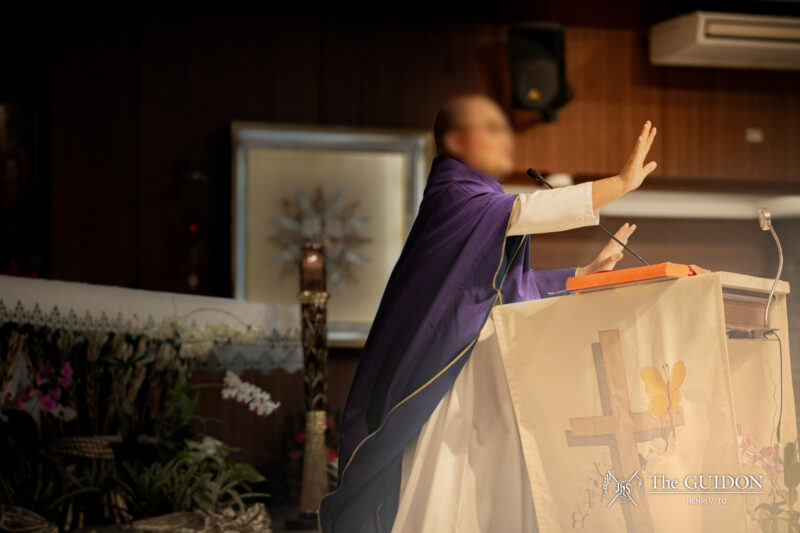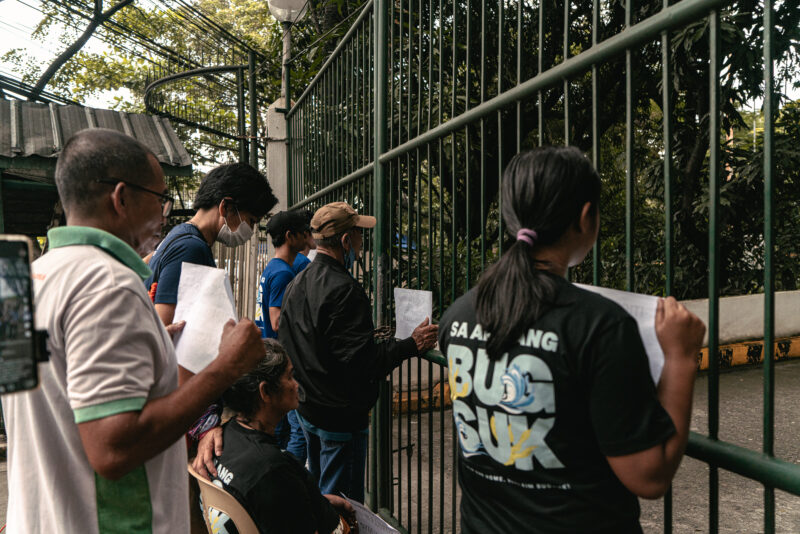It took Scott Kho (AB Comm ‘08) three site visits and 2 am wake up calls to take photographs of farmers in their struggle to regain land in Calatagan, Batangas.
Together with the Office for Social Concern and Involvement (OSCI), Scott had to work around the demanding schedule to arrive at the farmers’ hometown and take photos for OSCI’s exhibit project. “[My first visit] was a whole day affair and I got to talk to the farmers,” says Kho. “It was basically a process of understanding their situation and what they were fighting for.”
Kho is just one among members of the Ateneo community who believe that in order for the farmers to regain their land, their undertaking has to be visually documented for the world to see and for the government to take action.
Media exposure
While Kho learned more about the Calatagan farmers by tagging along their march, he says the process of taking photos hadn’t been easy. He recounts a time when rain started to pour as the farmers’ march from De La Salle University to the Ateneo progressed. “I brought the wrong pair of shoes and a thin pair of socks. I ended up walking the remaining two-thirds of the way with blistered, soaking wet feet.”
Mishaps aside, Kho says he was able to survey the situation from a broader perspective. “[The farmers’ story] speaks of every human being’s right to have a home and to live securely,” he says. “I [took photographs] to help make people aware of the things happening around us. What [the Calatagan farmers] were fighting for was not simply land to till but soil from which to grow their lives.”
Like Kho, Photojournalism Lecturer Jimmy Domingo is inclined to the photographic chronicling of social issues, particularly those in rural areas. In fact, he has been taking photographs of rural living for about 26 years now, from disease prevention efforts to tribal rituals to everyday provincial living.
Domingo, who was raised in a farming community, says he is probably one of the few photojournalists in the country who were able to document the farmers’ campaigns. Domingo followed the famers groups of Sumilao, Bukidnon, and Hacienda Velez-Malaga in Negros Occidental.
He had been involved with the Sumilao farmers’ campaign since it started in 1998. “I got interested in the 1,700-kilometer walk they did [last year],” he says. “Since I documented them already in 1998, the people already knew me. The kids back then are now young adults. They still remember me.”
He trailed with the Sumilao farmers along the Visayas leg of their march, seeing first hand their eating sardines on the road and sleeping on cartons on the floor. “[Marching with them is] the best way to take photos,” he says. “I had around eight gigabytes [worth of photos during those three days].”
Meanwhile, Domingo’s coverage of the Velez-Malaga sugarcane farmers exposed him to much harm. He recalls the time when he went to the site to take photos of the farmers who had just been granted back their land by the government. “Guards started shooting,” he says. “They were shooting and people were crying. I was very near them when that happened. When I got to the car, I edited the photos, plugged in captions, and e-mailed them immediately. The next day, my pictures were widely used by [the press].”
The best part of the experience, Domingo says, is his knowing the Sumilao and Velez-Malaga farmers. “It’s heartwarming,” he says.
Can we make it to Malacañang?
Last February 19, a screening of Lupang Hinarang, co-organized by the OSCI, the Development Society, and the Loyola Film Circle, was held in Escaler Hall. It is a documentary about the Sumilao and Velez-Malaga farmers’ journey to Manila. Lupang Hinarang is also by the film maker of award-winning documentaries Minsan Lang Sila Bata in 1996 and Bunso in 2004; she’s Ditsi Carolino.
A portion of the two-part film shows the Sumilao farmers taking naps on either side of the road, shaving their heads bald, and walking under the rain in black raincoats while shouting, “Can we make it to Malacañang? Yes!” Carolino says that such highlights of the marches are strong visual storybooks for the average Filipino viewer. She walked for four days with the Sumilao farmers for her coverage.
“My way of making a difference is by bringing this story and [sharing] it with other people because not everyone is given a chance to go to [the farming communities and interact with the farmers],” Carolino says in a mix of English and Filipino. “I’d like my films to be the first step, a window in a way, [to] this kind of reality.”
Carolino hopes the documentary, in its second half, is able to properly portray the farmers in their natural element, different from what mainstream media portrayed as the farmers rowdily protesting against the Department of Agriculture (DAR). She spent two weeks in Negros with the Velez-Malaga farmers and visited them during their 29-day hunger strike outside the DAR.
Seeing that both farmer cases against the DAR proved too successful, Carolino also grabbed the opportunity to put into film the farmers’ homecomings. She says, “You start to think of [the young farmers] and think that if this issue had been resolved earlier, they would’ve gone to school already.”
Carolino adds, “[Theirs is] a compelling story. People do not really see what’s wrong unless and until they get to know these farmers and understand what they go through. (…) It’s not just a social justice story that one should feel bad for the farmers’ misfortune. This is also an economic story. Until there hasn’t been an equitable distribution of resources, our country will not progress.”
In photos and film
Though several farmer groups have won back their land, lobbies for extension and reforms on the Comprehensive Agrarian Reform Program (CARP) of 1988 are still being debated on in Congress. Not all lawmakers are in agreement that there is a need for a new CARP. In consequence, not all farmers have access to till land that is theirs.
Thus photographers Domingo and Kho hope that, through their photos, people are able to understand the issue at hand. “Photos [are] able to show people the lengths some have to go through to achieve the things we normally take for granted,” says Kho. “That it is incumbent upon us all to try to do something about what is wrong in the world instead of just complaining.”
Domingo, meanwhile, says, “I always hope that my photographs inspire others to do [more for our society]. Through the photographs, greater awareness on the gravity of the problem [will arise] and [may be able to spur a] bigger interest to support [a] resolution [to] the problem.”
Different talents and capabilities can play a role in one’s involvement with social issues, says Carolino, and that the audience could act on the issue in a way they know best. “We all have our own talents so there are different ways of helping,” she says. “Kahit hindi ka pa handang handa, dahil may pangangailangan, tumugon ka. (Even if you’re not fully ready, because there’s a need, you answer to that need.) Whatever you have, jump.”







thanks! more power to the guidon!